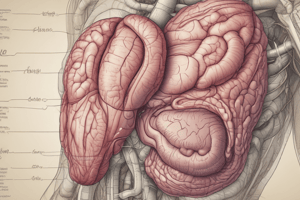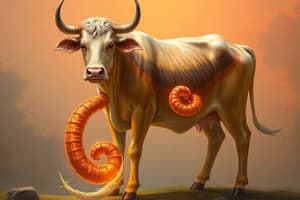Podcast
Questions and Answers
What drives water absorption in the hindgut?
What drives water absorption in the hindgut?
- Facilitated diffusion
- Paracellular transport
- Osmotic pressure gradients (correct)
- Active transport
Which integral membrane proteins facilitate the rapid transport of water molecules across cellular membranes in the hindgut?
Which integral membrane proteins facilitate the rapid transport of water molecules across cellular membranes in the hindgut?
- Aquaporins (correct)
- Ion channels
- Sodium-potassium pumps
- G protein-coupled receptors
What are the two main types of aquaporins identified in the intestinal epithelium for water movement in the hindgut?
What are the two main types of aquaporins identified in the intestinal epithelium for water movement in the hindgut?
- AQP7 and AQP8
- AQP3 and AQP4
- AQP1 and AQP2 (correct)
- AQP5 and AQP6
What is the function of paracellular pathways in water movement in the hindgut?
What is the function of paracellular pathways in water movement in the hindgut?
Which factor can influence aquaporin activity related to water absorption in the hindgut?
Which factor can influence aquaporin activity related to water absorption in the hindgut?
What is the role of salt absorption in the hindgut?
What is the role of salt absorption in the hindgut?
Which of the following is NOT a primary sodium-dependent cotransport system involved in NaCl absorption in the colon?
Which of the following is NOT a primary sodium-dependent cotransport system involved in NaCl absorption in the colon?
What is the primary mechanism by which salt absorption occurs in the hindgut?
What is the primary mechanism by which salt absorption occurs in the hindgut?
What is the role of the apical Na+/K+-ATPase in salt absorption?
What is the role of the apical Na+/K+-ATPase in salt absorption?
What is the role of the basolateral Na+/K+-ATPase in salt absorption?
What is the role of the basolateral Na+/K+-ATPase in salt absorption?
Which of the following statements about paracellular diffusion in salt absorption is correct?
Which of the following statements about paracellular diffusion in salt absorption is correct?
What is the role of mechanosensors in the gastrointestinal mucosa?
What is the role of mechanosensors in the gastrointestinal mucosa?
Flashcards are hidden until you start studying
Study Notes
Hindgut Biology: Understanding Water and Salt Absorption
The hindgut is the distal part of the digestive tract, where water and salt absorption occur. This process plays a crucial role in maintaining fluid balance and electrolyte homeostasis within the body. In this article, we will delve into the mechanisms behind water and salt absorption in the hindgut.
Water Absorption in Hindgut
Water absorption in the hindget occurs through passive diffusion, driven by osmotic pressure gradients established by transporters such as aquaporins. Aquaporins are integral membrane proteins that facilitate the rapid transport of water molecules across cellular membranes. They play a vital role in regulating water fluxes between intracellular and extracellular compartments.
In the intestinal epithelium, two main types of aquaporins have been identified: AQP1 and AQP2. These channels mediate both paracellular and transcellular pathways for water movement. Paracellular pathways involve the passage of water molecules through interstitial spaces between neighboring cells, while transcellular pathways involve direct transport through the cell membrane. The processes that control these movements include alterations in ion composition, changes in concentration, and adjustment of specific transporter activities.
Aquaporin activity can be influenced by various factors, including dietary intake and osmoregulatory hormones like vasopressin (arginine vasotocin) in fish. Additionally, some drugs targeting infectious diseases may affect aquaporin function, which could impact renal failure or other clinical outcomes.
Salt Absorption in Hindgut
Salt absorption in the hindgut also relies on various active transporters. Sodium chloride (NaCl), the primary constituent of table salt, is absorbed in the colon via several mechanisms:
Transporters
Three primary sodium-dependent cotransport systems are involved in NaCl absorption: the apical Na+/K+-ATPase, the basolateral Na+/K+-ATPase, and the Na+/HCO3- symporter. The apical Na+/K+-ATPase pumps sodium ions out of the enterocyte into the lumen, creating an electrochemical gradient for uptake of solute (e.g., glucose, amino acids) into the enterocytes. The basolateral Na+/K+-ATPase maintains sodium concentrations in the bloodstream, allowing for further exchange with other tissues. Lastly, the Na+/HCO3- symporter facilitates the simultaneous entry of Na+ and HCO3- from the lumen into the enterocyte.
Paracellular Diffusion
Paracellular diffusion also contributes to salt absorption in the hindgut. Ions diffuse passively through tight junctions between polarized epithelial cells, driven by the electrochemical gradient created by active transport mechanisms.
Tonicity Regulation
Tight regulation of tonicity within the gastrointestinal tract is essential for proper water and salt absorption. Cells in the gastrointestinal mucosa possess specialized receptors known as mechanosensors, which respond to changes in local volume and pressure. These sensors help maintain a balance of fluid and electrolytes within the tissue, ensuring that water and salt absorption proceeds in a controlled manner.
In summary, the hindgut plays a crucial role in the absorption of water and salt, which are vital for maintaining the body's fluid balance and electrolyte homeostasis. Both passive and active transport mechanisms are involved in these processes, with aquaporins facilitating water absorption and various sodium transporters responsible for salt absorption.
Studying That Suits You
Use AI to generate personalized quizzes and flashcards to suit your learning preferences.




